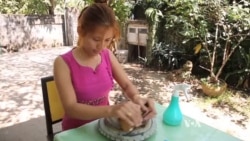The sartorial choices of Myanmar’s men and women quickly catch the eye of any visitor to this tropical Southeast Asian country.
Most girls and women, irrespective of age, adorn their cheeks with a distinctive yellowish-white paste, called thanaka.
Boys and men also sometimes apply the cosmetic made from ground bark but they mostly stand out to foreigners for their mode of dress: the longyi, a two meter long cylindrical printed cloth wrapped around the waist. Women also wear longyi in more flowery designs than men and tuck the knot on a black waistband to the side while the guys tie a knot in front.
Both the longyi and thanaka seem well-suited for the low altitude area of the country, where even in January, the coldest month, the temperature averages 25 degrees Celsius.
But at a time when Myanmar’s political and economic opening is bringing affordable western fashions to the masses, will the country’s unique fashion trends endure?
Not all fashion traditions here have deep roots.
The longyi is a relatively recent import, becoming popular during British colonial times and said to have been introduced by immigrants from southern India, although it also closely resembles a traditional loose-fitting Malay sarong.
Thanaka, which is usually made from the wood apple tree, has a more storied history, reputed to have been used by women in Burma for more than 2,000 years and touted as an antiseptic, to control acne and heal wounds.
“It makes my face feel cool under the hot and harsh sun," explained Aye Thandar Aung, a 25-year-old street vendor in Yangon. "My parents have been putting it on my face since I was born. So I've continued wearing thanaka."
The 25-year-old street vendor said she does not use any other makeup or lotions as her skin is allergic to foreign cosmetics.
Fashion designer May Myat Warso asserts thanaka is "uniquely suited for the skin of Myanmar people because of the hot weather here and it gives us a cooling effect."
She said for her work she has to wear Western makeup but, "I always put on thanaka when I get back home."
Thanaka is now sold prepared in jars and plastic tubes but many women still prefer to make their own. They vertically grind in a circular motion small branches and logs on a flat whetstone, applying a bit of water, to produce the milky yellow liquid which is immediately dabbed on the face and arms.
On the cheeks thanaka is usually applied in a circular pattern but some users are more stylish creating patterns using intricate leaf stencils.
At the counter of the Mon Cosmetics Shop in Yangon's Yuzana Plaza saleswoman Kha Yay, 22, notes a change of trends with "most teenagers wearing makeup now. Some wear it together with thanaka."
Even though she is selling Western cosmetics, thanaka -- with a fragrance similar to sandalwood -- is on her cheeks.
"I came to work very early and didn't have enough time to put on make-up," she said.
One floor below the cosmetics shop in Yuzana Plaza, Aung Zin is managing a store which sells counterfeit Levi's and other faux name-brand jeans made in China.
The pants, at around $20 each, are only slightly more expensive than the typical longyi, traditionally handwoven at home but now usually store bought.
"We still… wear longyi for special occasions, such as going to temples, so longyi will never disappear,” the jeans store manager predicts.
Maung Maung, one floor below the jeans shop, concurs. He is the second-generation owner of the Mya Nilar Longyi Shop.
“I feel more free in longyi than jeans or pants. Longgyi are especially suited with Myanmar's climate. That’s why most men here like to wear longyi," he explained. “Jeans have been getting popular in Myanmar in the last 10 years. And I used to [think] longyi would disappear. But, so far, they haven't and they'll last forever as our traditional dress."
His shops also sells silk longyi worn for special occasions.
Designer May Myat Warso of the Happy Heart Fashion House, said she finds men more attractive clad in longyi.
She believes thanaka and longyi have grace and "for sure" could become fashionable in the West with its ever-changing styles. But others here wonder with Myanmar having recently emerged from decades of virtual isolation under military rule to what extent traditional customs will endure.










